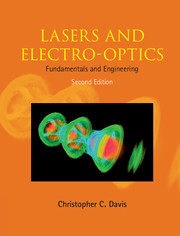Book contents
- Frontmatter
- Contents
- Preface to the Second Edition
- 1 Electromagnetic waves, light, and lasers
- 2 Optical frequency amplifiers
- 3 An introduction to two practical laser systems
- 4 Optical resonators containing amplifying media
- 5 Laser radiation
- 6 Control of laser oscillators
- 7 Optically pumped solid-state lasers
- 8 Gas lasers
- 9 Molecular gas lasers I
- 10 Molecular gas lasers II
- 11 Tunable lasers
- 12 Semiconductor lasers
- 13 Passive optical systems
- 14 Periodic optical systems, resonators, and inhomogeneous media
- 15 The optics of Gaussian beams
- 16 Optical fibers and waveguides
- 17 The optics of anisotropic media
- 18 The electro-optic and acousto-optic effects and modulation of light beams
- 19 Introduction to nonlinear processes
- 20 Wave propagation in nonlinear media
- 21 Detection of optical radiation
- 22 Coherence theory
- 23 Laser applications
- Appendix 1 Optical terminology
- Appendix 2 The ´-function
- Appendix 3 Black-body radiation formulas
- Appendix 4 RLC circuits
- Appendix 5 Storage and transport of energy by electromagnetic fields
- Appendix 6 The reflection and refraction of a plane electromagnetic wave at a boundary between two isotropicmedia of different refractive indices
- Appendix 7 The vector differential equation for light rays
- Appendix 8 Symmetry properties of crystals and the 32 crystal classes
- Appendix 9 Tensors
- Appendix 10 Bessel-function relations
- Appendix 11 Green's functions
- Appendix 12 Recommended values of some physical constants
- Index
- References
23 - Laser applications
Published online by Cambridge University Press: 05 June 2014
- Frontmatter
- Contents
- Preface to the Second Edition
- 1 Electromagnetic waves, light, and lasers
- 2 Optical frequency amplifiers
- 3 An introduction to two practical laser systems
- 4 Optical resonators containing amplifying media
- 5 Laser radiation
- 6 Control of laser oscillators
- 7 Optically pumped solid-state lasers
- 8 Gas lasers
- 9 Molecular gas lasers I
- 10 Molecular gas lasers II
- 11 Tunable lasers
- 12 Semiconductor lasers
- 13 Passive optical systems
- 14 Periodic optical systems, resonators, and inhomogeneous media
- 15 The optics of Gaussian beams
- 16 Optical fibers and waveguides
- 17 The optics of anisotropic media
- 18 The electro-optic and acousto-optic effects and modulation of light beams
- 19 Introduction to nonlinear processes
- 20 Wave propagation in nonlinear media
- 21 Detection of optical radiation
- 22 Coherence theory
- 23 Laser applications
- Appendix 1 Optical terminology
- Appendix 2 The ´-function
- Appendix 3 Black-body radiation formulas
- Appendix 4 RLC circuits
- Appendix 5 Storage and transport of energy by electromagnetic fields
- Appendix 6 The reflection and refraction of a plane electromagnetic wave at a boundary between two isotropicmedia of different refractive indices
- Appendix 7 The vector differential equation for light rays
- Appendix 8 Symmetry properties of crystals and the 32 crystal classes
- Appendix 9 Tensors
- Appendix 10 Bessel-function relations
- Appendix 11 Green's functions
- Appendix 12 Recommended values of some physical constants
- Index
- References
Summary
When the laser was first invented, it was described as “a solution looking for a problem.” This comment did not long survive scrutiny, and nowadays lasers are ubiquitous in many aspects of daily life, with many technological, artistic, and educational applications. This chapter highlights some of the important application areas where lasers have become essential.
Optical communication systems
Introduction
Optical communications systems have a long history. Ancient man signaled with smoke and fire, often relaying messages from mountain top to mountain top. However, this optical communication scheme had limited transmission capacity. Such messages could serve as a warning, as Queen Elizabeth the First of England planned when she had a network of bonfires erected to be set in the event of a seaborne invasion from Spain. The smoke signals transmitted by native Americans had the capacity to transmit various messages. Since the end of the eighteenth century,messages have been passed by semaphore – the use of flags to indicate the transmission of one letter at a time. This form of communication could transmit information at a rate of about one letter per second over a direct line of sight, although messages could be relayed over long distances. Such means of communication were not very secure: anyone in the line of sight to the message sender could read the information (if he or she knew the code).
- Type
- Chapter
- Information
- Lasers and Electro-opticsFundamentals and Engineering, pp. 783 - 820Publisher: Cambridge University PressPrint publication year: 2014



